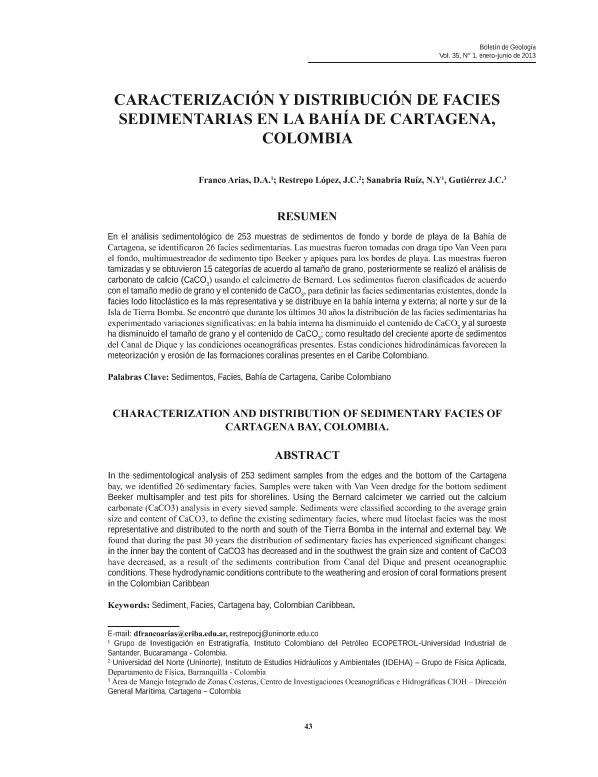Mostrar el registro sencillo del ítem
dc.contributor.author
Franco Arias, Diana Aillen

dc.contributor.author
Restrepo López, J. C.
dc.contributor.author
Sanabria Ruiz, N. Y.
dc.contributor.author
Gutierrez, Julio C.
dc.date.available
2016-07-22T14:09:55Z
dc.date.issued
2013-05
dc.identifier.citation
Franco Arias, Diana Aillen; Restrepo López, J. C.; Sanabria Ruiz, N. Y.; Gutierrez, Julio C.; Caracterización y distribución de facies sedimentarias en la Bahía de Cartagena, Colombia; Universidad Industrial de Santander; Boletín de Geología; 35; 1; 5-2013; 43-53
dc.identifier.issn
0120-0283
dc.identifier.uri
http://hdl.handle.net/11336/6632
dc.description.abstract
En el análisis sedimentológico de 253 muestras de sedimentos de fondo y borde de playa de la Bahía de Cartagena, se identificaron 26 facies sedimentarias. Las muestras fueron tomadas con draga tipo Van Veen para el fondo, multimuestreador de sedimento tipo Beeker y apiques para los bordes de playa. Las muestras fueron tamizadas y se obtuvieron 15 categorías de acuerdo al tamaño de grano, posteriormente se realizó el análisis de carbonato de calcio (CaCO3) usando el calcímetro de Bernard. Los sedimentos fueron clasificados de acuerdo con el tamaño medio de grano y el contenido de CaCO3, para definir las facies sedimentarias existentes, donde la facies lodo litoclástico es la más representativa y se distribuye en la bahía interna y externa; al norte y sur de la Isla de Tierra Bomba. Se encontró que durante los últimos 30 años la distribución de las facies sedimentarias ha experimentado variaciones significativas: en la bahía interna ha disminuido el contenido de CaCO3 y al suroeste ha disminuido el tamaño de grano y el contenido de CaCO3; como resultado del creciente aporte de sedimentos del Canal de Dique y las condiciones oceanográficas presentes. Estas condiciones hidrodinámicas favorecen la meteorización y erosión de las formaciones coralinas presentes en el Caribe Colombiano.
dc.description.abstract
In the sedimentological analysis of 253 sediment samples from the edges and the bottom of the Cartagena bay, we identified 26 sedimentary facies. Samples were taken with Van Veen dredge for the bottom sediment Beeker multisampler and test pits for shorelines. Using the Bernard calcimeter we carried out the calcium carbonate (CaCO3) analysis in every sieved sample. Sediments were classified according to the average grain size and content of CaCO3, to define the existing sedimentary facies, where mud litoclast facies was the most representative and distributed to the north and south of the Tierra Bomba in the internal and external bay. We found that during the past 30 years the distribution of sedimentary facies has experienced significant changes: in the inner bay the content of CaCO3 has decreased and in the southwest the grain size and content of CaCO3 have decreased, as a result of the sediments contribution from Canal del Dique and present oceanographic conditions. These hydrodynamic conditions contribute to the weathering and erosion of coral formations present in the Colombian Caribbean
dc.format
application/pdf
dc.language.iso
spa
dc.publisher
Universidad Industrial de Santander
dc.rights
info:eu-repo/semantics/openAccess
dc.rights.uri
https://creativecommons.org/licenses/by-nc-sa/2.5/ar/
dc.subject
Sedimentos
dc.subject
Facies
dc.subject
Bahía de Cartagena
dc.subject
Caribe Colombiano
dc.subject.classification
Oceanografía, Hidrología, Recursos Hídricos

dc.subject.classification
Ciencias de la Tierra y relacionadas con el Medio Ambiente

dc.subject.classification
CIENCIAS NATURALES Y EXACTAS

dc.title
Caracterización y distribución de facies sedimentarias en la Bahía de Cartagena, Colombia
dc.title
Characterization and distribution of sedimentary facies of Cartagena Bay, Colombia.
dc.type
info:eu-repo/semantics/article
dc.type
info:ar-repo/semantics/artículo
dc.type
info:eu-repo/semantics/publishedVersion
dc.date.updated
2016-07-12T15:19:34Z
dc.journal.volume
35
dc.journal.number
1
dc.journal.pagination
43-53
dc.journal.pais
Colombia

dc.journal.ciudad
Bucaramanga
dc.description.fil
Fil: Franco Arias, Diana Aillen. Consejo Nacional de Investigaciones Científicas y Técnicas. Centro Científico Tecnológico Bahía Blanca. Instituto Geológico del Sur; Argentina. Universidad Industrial de Santander; Colombia
dc.description.fil
Fil: Restrepo López, J. C.. Universidad del Norte; Colombia
dc.description.fil
Fil: Sanabria Ruiz, N. Y.. Universidad Industrial de Santander; Colombia
dc.description.fil
Fil: Gutierrez, Julio C.. Centro de Investigaciones Oceanográficas e Hidrográficas; Colombia
dc.journal.title
Boletín de Geología
dc.relation.alternativeid
info:eu-repo/semantics/altIdentifier/url/http://revistas.uis.edu.co/index.php/revistaboletindegeologia/article/view/3225
dc.relation.alternativeid
info:eu-repo/semantics/altIdentifier/url/http://ref.scielo.org/5frjy5
dc.relation.alternativeid
info:eu-repo/semantics/altIdentifier/url/http://www.redalyc.org/articulo.oa?id=349631996004
dc.relation.alternativeid
info:eu-repo/semantics/altIdentifier/url/https://dialnet.unirioja.es/servlet/articulo?codigo=4382925
Archivos asociados
